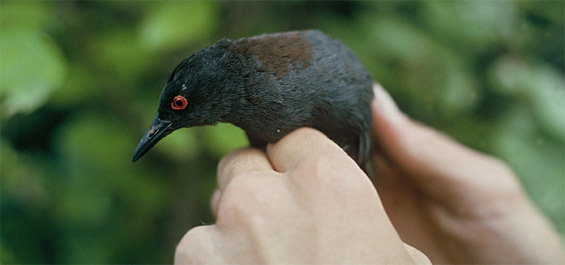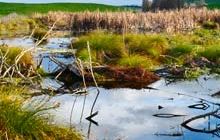Spotless crake/pūweto
Introduction
The at risk spotless crake/pūweto is a native subspecies which inhabits wetlands throughout New Zealand.New Zealand status: Native
Conservation status: Declining
Found in: Widely scattered throughout New Zealand, but most common in the upper North Island
Threats: Predation, habitat loss
Species information: Spotless crake/pūweto on NZ Birds Online
The spotless crake (Porzana tabuensis plumbea), or pūweto as it is known to Maori, is a cryptic bird of freshwater wetlands throughout North Island and much of South Island.
This small dark coloured rail (about half the size of a common blackbird) is very secretive and relatively infrequently seen, however their furtive nature and apparent mobility mean they could be present in areas of suitable habitat far from known populations.
Spotless crakes have declined dramatically since humans began draining wetlands and are now classed as at risk relict.
Where are they found?
The population is widely scattered in New Zealand, being sparsely distributed on the three main islands and many small offshore islands, but most common in the upper North Island.
On the mainland the spotless crake is predominantly a bird of freshwater wetlands dominated by dense emergent vegetation, particularly raupo (Typha orientalis).
This crake may forage on open mud near dense vegetation but is quick to retreat when disturbed. Spotless crakes live in dry forest on some small offshore islands.
When Europeans arrived spotless crake were abundant, but populations there have undergone dramatic declines.
Nationally, the most important sites for spotless crake are:
- The Awarua-Waituna wetland complex in Southland
- Great Barrier Island
- Kermadec Islands
- Lake Wairarapa
- Poor Knights Islands
- Tiritiri Matangi Island
- Whangamarino wetland in Waikato.
Quick facts
- Spotless crakes are small water birds
- They are about 20 cm in size, and weigh around 45 g
- They are rarely seen and their population numbers are unknown.
- Very dark general appearance, with dark brown plumage on the upper parts and dark bluish grey beneath.
- The legs are orange-pink and the bright red eyes contrast sharply with the dark head.
- The stout bill is black.
- Juveniles are paler with a white chin and throat.
- Little is known of spotless crake behaviour and ecology.
- They are very secretive and largely crepuscular.
- Spotless crakes seldom venture far from the cover of vegetation during daylight.
- Pairs and some single birds defend territories.
- Spotless crakes may migrate locally, as other subspecies do overseas.
- Spotless crakes are heard more often than seen.
- They are most conspicuous from their calls in spring and early summer.
- Several different calls are given, including bubbling sounds, a short 'pit-pit', a repeated 'mook' and the loudest call, a long trilling 'purr'.
- They are similar in size and shape to a marsh crake, however marsh crakes are much more strikingly patterned.
Breeding
Spotless crake are solitary and monogamous and breeding occurs deep in wetlands.
The nest cup of woven grass and sedge leaves is raised 30–50 cm above water level in mainland wetlands (nests on predator free islands are at ground level), often in a clump of Carex sedge. Several nest-like platforms are often built near the actual nest.
A clutch of 2–5 dull creamy-brown or pinkish coloured eggs is laid from late August to January and incubated by both parents for 20–22 days.
The chicks are capable of catching live prey from 3 days old and remain in the nest for up to 4 days. They are cared for by both parents for 4–5 months and parents may feign injury to distract predators. Spotless crake may have up to two successful broods per season.
Diet
Spotless crakes have a broad omnivorous diet, feeding on seeds, fruit and leaves of aquatic plants, and a wide variety of invertebrates including worms, snails, spiders, beetles and other insects.
They are a potential indicator of wetland health because they are dependent on the presence of high quality and ecologically diverse habitats and rich food supplies.
Threats
The main threats to spotless crake/pūweto are:
- Habitat clearance and drainage has had a significant impact on spotless crake. Over 90% of lowland freshwater wetlands have been drained and cleared for agriculture since Europeans settled New Zealand. Degradation of the remaining wetlands continues with grazing, water pollution and taking of water for other uses being major threats.
- Continued habitat modification including the loss of food supplies.
- Predation by introduced mammals such as cats, dogs, mustelids and rats. Cats appear to be a major threat to spotless crake, based on historic and current data. The presence of spotless crakes in dry forest on predator free islands also suggests they may have formerly used a wider range of habitats.
Other factors which impact on the spotless crake/pūweto:
- Road-kills and flying into power lines are also causes of deaths.
- Nesting crakes are sensitive to disturbance by humans.

Adult spotless crake/pūweto in hand
Our work
Wetlands support a wide range of threatened bird species in New Zealand. However, management techniques for restoring their populations are poorly developed.
DOC is focusing on developing methods for surveying spotless crakes systematically. These methods will enable people to establish baseline data and distribution maps; identify important wetland habitat types for conservation and measure the response to management such as pest control; and habitat maintenance and restoration.
DOC has been developing ‘call counts’ for spotless crakes. These take place with either an observer listening for set times at dawn or dusk using call lures, or with new automatic recorders (electronic recorders developed by the DOC Electronics Lab) recording calls remotely.
In addition DOC is actively developing methods for restoring wetlands through its Arawai Kākāriki Programme. Restoration involves developing a wide range of management tools including methods for controlling introduced predators, methods for managing water levels and restoring wetland vegetation.
You can help
Report all sightings or calls of spotless crakes to your nearest DOC office.

